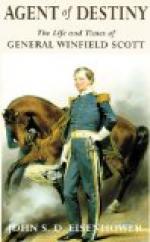General Scott felt compelled, on account of his reduced numbers, to order the garrison, under Colonel Childs at Jalapa, to join him. His force now was (including late re-enforcements) about fourteen thousand men, including two thousand five hundred sick in hospitals, and six hundred convalescents too feeble for duty. These convalescents and the same number of effective troops were left as a garrison under Colonel Childs, who was appointed commandant of the city of Puebla. This necessitated the almost total abandonment of the protection of his lines to his base at Vera Cruz, and communications to his Government. As Scott expressed it, “we had to throw away the scabbard and to advance with the naked blade in hand.”
CHAPTER X.
Movement toward the City of Mexico—The Duke of Wellington’s comments—Movements of Santa Anna—A commission meets General Worth to treat for terms—Worth enters Puebla—Civil administration of the city not interfered with—Scott arrives at Puebla—Scott’s address to the Mexicans after the battle of Cerro Gordo—Contreras—Reconnoissance of the pedregal—Defeat of the Mexicans at Contreras—Battle of Churubusco—Arrival of Nicholas P. Trist, commissioner—General Scott meets a deputation proposing an armistice—He addresses a communication to the head of the Mexican Government—Appointment of a commission to meet Mr. Trist—Major Lally—Meeting of Mr. Trist with the Mexican commissioners—Failure to agree—Armistice violated by the Mexicans and notice from General Scott—Santa Anna’s insolent note—The latter calls a meeting of his principal officers—Molino del Rey—Chapultepecec—Losses on both sides.
The army began its movement from Puebla toward the City of Mexico on August 6, 1847. Twiggs’s division was in the advance, General William Selby Harney’s cavalry leading and the siege train bringing up the rear. The other three divisions followed successively on the 8th, 9th, and 10th. No division was at any time more than seven or eight miles from support. It was expected that the army of Santa Anna would be met at Rio Frio, and hence General Scott’s great caution in his movement to keep his divisions in supporting distance.
The Duke of Wellington was so interested in this march of the army from Vera Cruz to the Mexican capital that he caused its movements to be marked on a map daily, as information was received. Admiring its triumphs up to the basin of Mexico, he now said: “Scott is lost. He has been carried away by successes. He can’t take the city, and he can’t fall back upon his base.”
General Santa Anna, finding himself without money and with but a small following of troops at Orizaba, marched by way of Aculcingo and Amasoque to Puebla. In the meantime he was using all efforts to gather re-enforcements for his army. There was but one day’s interval between the troops of General Worth and the Mexican brigades of Leonard Perez and the cavalry under General Alcorta, the whole of which was commanded by General Santa Anna when he passed Amasoque. Finding that he could not successfully defend Puebla, the Mexican general withdrew to San Martin and Amasoque. Soon afterward he moved on the road toward the City of Mexico.




